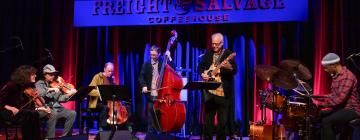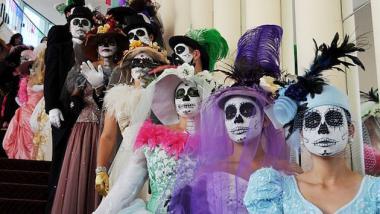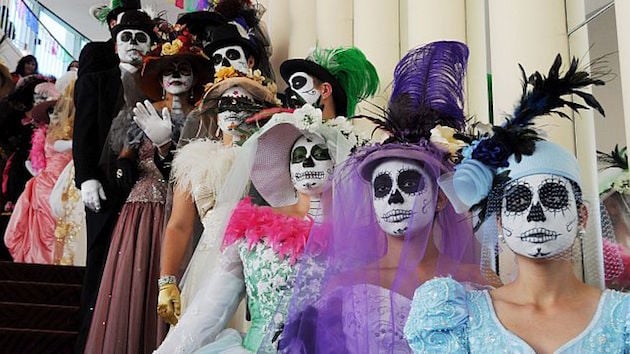
San Francisco Symphony’s celebrations of Día de los Muertos (Day of the Dead) will be held in three events in Davies Hall on Nov. 5. Before last year, there was only one concert, but demand for tickets became so great, the Symphony doubled the concerts, at 2 and 8 p.m., and added a seated brunch at 11 a.m. in the Wattis Room, complete with mimosas, sangria, and special guest speakers.
Why the popularity? The Mexican holiday, widely celebrated in the U.S. as well, coincides with the Christian observations of All Saints’ Eve, All Saints’ Day, and All Souls’ Day, and the secular offshoot of Halloween. Both Día and Day focus on gatherings of family and friends to remember loved ones who have died, and help support their spiritual journey. And, like Halloween, which falls on Oct. 31, these observations represent “death-defying” celebration of life, similar to an Irish wake.
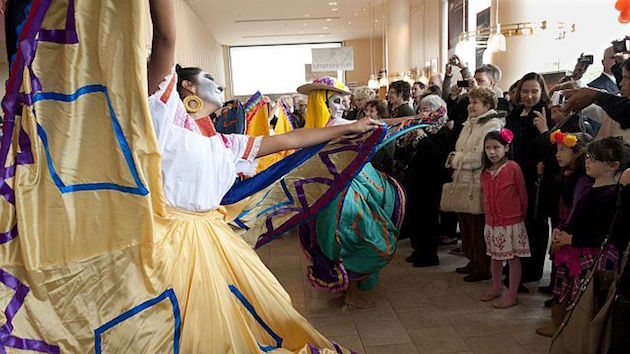
The Symphony’s version combines celebration, music, dance, and aspects of historic and folk tradition. Says Martha Rodriguez, curator and music adviser for the SFS Día de los Muertos: “We present the traditions from the perspective of Latinos living in the United States, featuring guest performers La Santa Cecilia and Mariachi Flor de Toloache. Both groups are based in the U.S. and both fuse traditional Latin folk music with other North American musical styles to create a new musical and social identity.”
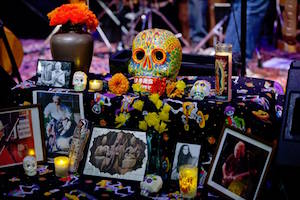
There will be ofrendas (shrines to honor the dead) and installations from artists living in the Bay Area, including Ester Hernandez, Viva Paredes, Indira Urrutia, Fernando Escartiz, Adela Juarez, and students from Casa Círculo Cultural and Creativity Explored.
SFS Associate Director of Artistic Planning Richard Lonsdorf speaks of the work of Latino artists who are living in the U.S., creating a fusion of musical styles: “They are not only bringing over traditional Mexican and other Latino traditions, but they are also drawing on the huge musical palette that is available in the United States, and bringing other flavors to their music, especially styles such as jazz, ska, rock, and even hip hop.”
This is the ninth year of Symphony’s Día de los Muertos festivities, and by now, Lonsdorf says, programming “matured” to the point of delving into a particular expression of Mexican and Latino cultural heritage in San Francisco:
Their music is reflective of how young, multicultural artists think about their own heritage, which doesn’t necessarily translate into drawing a firm line between this culture or that culture, but more so charting their own course through it.
For instance, Mariachi Flor de Toloache, who is flouting tradition just by being an all-female Mariachi group, is also a group that draws on a variety of different musical traditions. I recommend listening to their “Blue Medley,” which starts out with a ska version of “Blue Skies” before transitioning into music that shows more indigenous instrumental techniques. Their album is so fun to listen to, because they have a really unique twist on so many different musical elements.
And likewise La Santa Cecilia is drawing from a lot on different street styles of music, party band music, and all other kinds of fusion styles. They are almost like a fusion of fusions. They are so high octane, fun, and infectious. A live concert with them is an absolute party; it is so uplifting and fun. Both of these groups, by virtue of their experiences and the many styles that influence them, are going to paint a very broad and inclusive musical and cultural picture for our show that will be very welcoming to all kinds of audiences.
Also participating: Casa Círculo Cultural theater group, and the women of the San Francisco Symphony Chorus, led by David Xiques, singing Alavez’s “Cancion Mixteca,” and traditional songs “La Bruja,” “Las Amarillas.”
